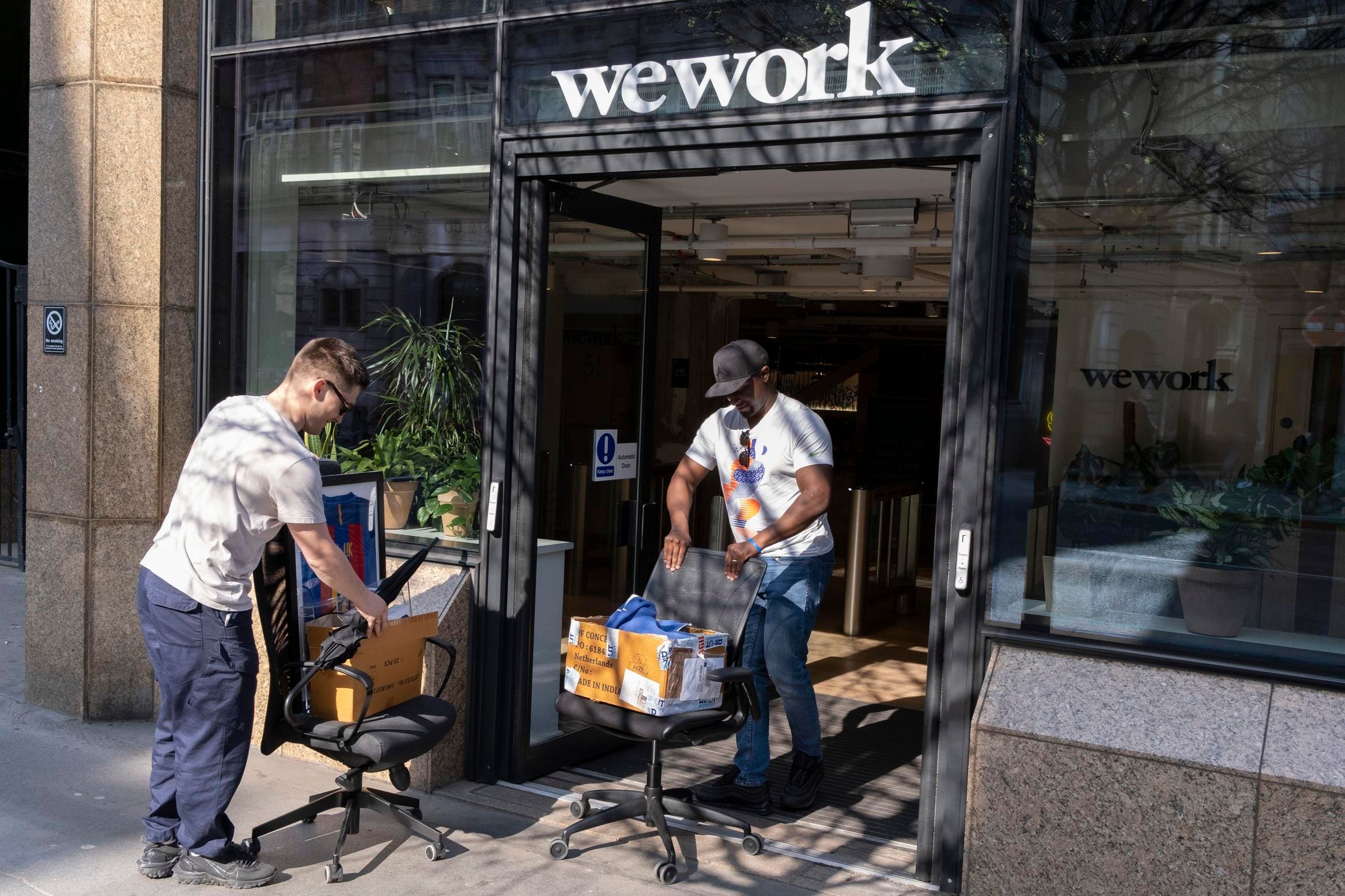
The news is full of stories regarding yesterday’s call by WeWork to its landlords serving notice that they were seeking to renegotiate nearly all their leases. This was accompanied by a letter from WeWork CEO David Tolley who stated inter alia that “[a]s part of these negotiations, we expect to exit unfit and underperforming locations” in order “to achieve the sustainable operating model that we need“. Mr. olley concluded his letter by saying that “WeWork is here to stay. We will remain a global flex space leader, and trusted real estate partner to our members.”
This unusual gambit was clearly intended to set the tone for negotiations and provide WeWork with the upper hand in the discussions between their real estate advisor Hilco Global and the company’s landlords. As is my wont on these matters, I consulted the general counsel of Wharton Property Advisors Eric Haber who is also a bankruptcy attorney, for his take on the situation.
Eric’s view is that once again WeWork is trying to have its cake and eat it too. Said less colloquially, WeWork is trying to obtain the benefits of bankruptcy outside of court without filing an actual case with the attendant risk of having its shareholders wiped out or significantly diluted.
In most situations, this type of aggressive strategy in negotiating with creditors would probably not work for a debtor prior to a possible Chapter 11 filing because it generally has little negotiating leverage with vendors and lenders. However, in this instance because of the weakness of the office market around the world some landlords may be receptive to the opportunity to negotiate with WeWork because they simply do not have any replacement tenants lined up, nor do they anticipate having them. As a result, WeWork has considerable bargaining power, as it publicly announced with its call and the Tolley letter.
That said, one issue that is unclear is how WeWork plans to exit locations that are underperforming where the landlord refuses to negotiate outside of a bankruptcy without a substantial buyout for longer leases. But WeWork’s real leverage arises out of what could happen to landlords in a bankruptcy proceeding. That is because the Bankruptcy Code allows a debtor to reject leases and caps the unsecured rejection damage claim of the landlord at the greater of (a) one year’s rent or (b) 15% of the remaining rent due on the lease, not to exceed three years. In many instances, this means that the landlord will receive pennies on the dollar at best.
Further, WeWork has used this playbook several times before. In fact, according to the Real Deal WeWork has already renegotiated or terminated 590 leases, saving $12.7 billion in leasing costs since 2019. However, that obviously did not do the job as the company continues to hemorrhage cash.
Nevertheless, WeWork is back for another bite at the (Big) Apple, where it accounts for approximately 6.4 million square feet of a 414 million square foot square foot market. As WeWork has considerably reduced its office footprint already, the situation could have been worse, but it just adds to the pain that the sector is suffering. Will WeWork’s plan work? That remains to be seen.
The bottom line with any company seeking to reorganize in or out of court is that it needs to have a successful underlying business. According to Mr. Tolley’s letter, lease costs represent over 2/3 of WeWork’s operating expenses so if they can achieve meaningful concessions, maybe they have a fighting chance. However, we have seen this movie before so time will tell. We are just at the beginning of the latest chapter of the fascinating WeWork story.
- SEO Powered Content & PR Distribution. Get Amplified Today.
- PlatoData.Network Vertical Generative Ai. Empower Yourself. Access Here.
- PlatoAiStream. Web3 Intelligence. Knowledge Amplified. Access Here.
- PlatoESG. Automotive / EVs, Carbon, CleanTech, Energy, Environment, Solar, Waste Management. Access Here.
- PlatoHealth. Biotech and Clinical Trials Intelligence. Access Here.
- ChartPrime. Elevate your Trading Game with ChartPrime. Access Here.
- BlockOffsets. Modernizing Environmental Offset Ownership. Access Here.
- Source: https://www.forbes.com/sites/ruthcolp-haber/2023/09/07/insights-on-weworks-office-space-strategy/
- :has
- :is
- :not
- :where
- $UP
- 11
- 15%
- 2019
- 7
- a
- accompanied
- According
- Accounts
- Achieve
- actual
- Adds
- advisor
- advisors
- again
- aggressive
- All
- allows
- already
- also
- an
- and
- announced
- Another
- anticipate
- any
- Apple
- approximately
- ARE
- around
- AS
- At
- attorney
- b
- back
- Bankruptcy
- BE
- because
- been
- before
- Beginning
- benefits
- BEST
- between
- Big
- Billion
- Bottom
- business
- but
- Buyout
- by
- CAKE
- call
- CAN
- caps
- case
- Cash
- ceo
- Chance
- Chapter
- Chapter 11
- claim
- clearly
- code
- company
- Company’s
- concessions
- concluded
- considerable
- considerably
- continues
- Costs
- could
- counsel
- Court
- creditors
- damage
- David
- deal
- DID
- diluted
- discussions
- do
- Dollar
- due
- eat
- estate
- exceed
- Exit
- expect
- expenses
- fact
- fascinating
- Feet
- fighting
- Filing
- Foot
- Footprint
- For
- Forbes
- from
- full
- Gambit
- General
- generally
- Global
- greater
- hand
- happen
- Have
- having
- here
- his
- How
- However
- HTTPS
- i
- if
- in
- insights
- instance
- intended
- issue
- IT
- ITS
- Job
- jpg
- just
- landlord
- latest
- leader
- leases
- leasing
- lenders
- less
- letter
- Leverage
- Line
- lined
- little
- locations
- longer
- many
- Market
- Matters
- May..
- maybe
- meaningful
- means
- Members
- million
- model
- most
- movie
- mr
- my
- nearly
- needs
- negotiations
- news
- nor
- Notice..
- obtain
- of
- Office
- on
- once
- ONE
- operating
- operating expenses
- Opportunity
- or
- order
- our
- out
- outside
- over
- Pain
- part
- partner
- plan
- plans
- plato
- Plato Data Intelligence
- PlatoData
- possible
- power
- Prior
- probably
- property
- provide
- publicly
- real
- real deal
- real estate
- receive
- Reduced
- regarding
- remain
- remaining
- remains
- Rent
- replacement
- represent
- result
- Risk
- Said
- saving
- saying
- sector
- seeking
- seen
- serving
- set
- several
- Shareholders
- significantly
- simply
- since
- situation
- situations
- So
- some
- Space
- square
- stated
- stay
- Stories
- Story
- Strategy
- substantial
- successful
- suffering
- sustainable
- Take
- tell
- tenants
- that
- The
- the world
- their
- Them
- These
- they
- this
- three
- time
- times
- to
- TONE
- too
- trusted
- type
- underlying
- unsecured
- unusual
- used
- vendors
- View
- was
- we
- weakness
- were
- wework
- wharton
- What
- WHO
- will
- with
- without
- Work
- world
- worse
- would
- years
- zephyrnet












